How to Choose the Best Marketing Attribution Model
As a business, an increase in sales can feel like achieving the ultimate goal, fueling your campaign objectives financially, but it’s also important to consider: where did those purchases come from? How did the customer come across your brand and what pushed them towards making that final purchase?
A customer’s journey and the steps they’ve taken to get to a sale can be just as important as where the sale took place. Using attribution models, marketers can assign credit to touchpoints along the consumer’s buying journey. This can provide more insight on which marketing channels perform best to allocate more dollars and maximize ROI.
With a data-driven approach, a business can further use the strategic insights to expand on what’s working and utilize their learnings for future campaigns.
How Attribution Works
Oftentimes a consumer’s conversion path takes place on more than one device and it’s likely they’ve come across numerous different touchpoints before making the decision to purchase.
Touchpoints can be defined as a series of interactions a company has with a consumer at any stage in their customer journey. These touchpoints can consist of social media, radio, television, email and other opportunities where engagement may occur between the consumer and a business.
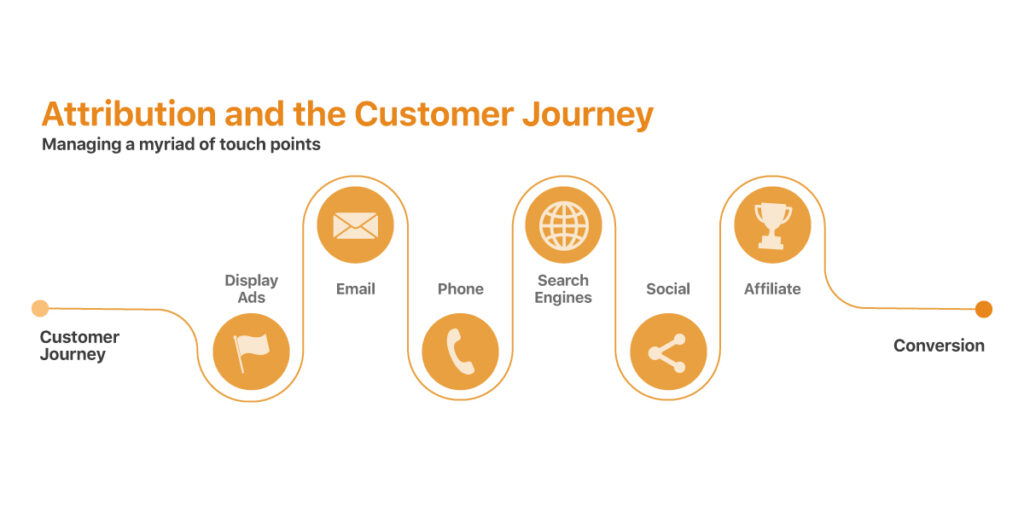
Attribution models use a set of rules or statistical modelling to assign conversion credit. When it comes to the different types of modelling, there are numerous options that can be applicable to your business.
Single attribution models credit only one touchpoint within a customer’s journey, including both first and last touch attribution. Meanwhile, multi-touch models look at a customer’s full conversion path, which may include positional, linear, time-decay and data-driven attribution.
Today we’ll be covering six common attribution models:
- First touch
- Last touch
- Position-Based
- Linear
- Time Decay
- Data-Driven
1. First Touch Attribution
The first touchpoint a consumer interacts with is credited with 100% of the conversion. No subsequent touchpoints are used to measure success or incrementality. This model is useful for conversion paths that have larger attribution windows or when a longer consideration period is required. In addition, this attribution model is beneficial when prioritizing the acquisition of top funnel customers.
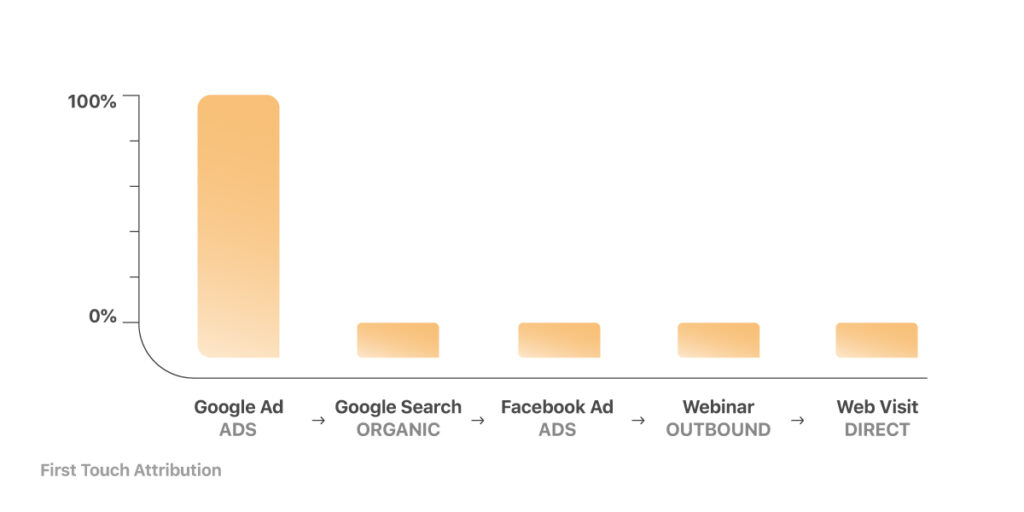
For example:
- A local gym is looking to acquire more memberships for its facility.
- A potential lead discovers the business through a Facebook ad while scrolling through their newsfeed. The individual clicks through and signs up for a newsletter.
- Two days later, the prospect receives an email newsletter from the gym and visits the website again and looks at the membership deals.
- Finally, the prospect converts a day later and signs up for a membership after being served a Google search ad from the gym.
In this scenario, 100% of the credit for the conversion is attributed to the Facebook ad and all other touchpoints are not taken into consideration. After collecting enough data, the gym can determine which source led the prospect to take their first step towards being acquired and ultimately, optimize more dollars towards that channel.
2. Last Touch Attribution
The last touchpoint a consumer interacts with is credited with 100% of the conversion. When measuring success with smaller attribution windows (shorter buying cycles or low-consideration conversions), this model can assist with determining value of the last touchpoint. No prior touchpoints are taken into consideration.

For example:
- A business is attempting to drive audiences to its website to purchase a coffee maker.
- A prospect visits the website after viewing a Snapchat ad from the business but doesn’t make a purchase.
- Three days later, the individual sees a Facebook ad from the same business, clicks through to the website and buys the coffee maker.
In this case, 100% of the credit for the conversion is attributed to the Facebook ad and any prior influences from the Snapchat ad are ignored. Using the last touch model, a business can identify the channel that best closes customers.
Most advertising platforms such as Facebook Ads Manager, LinkedIn campaign manager and Google Ads will utilize the last touch attribution model by default.
3. Position-Based Attribution
Also known as U-shape attribution, this model takes into consideration the full conversion path. The first and last touchpoints are credited with the most weight. Middle touchpoints are also credited, but with less weight and evenly distributed amongst each other. This model is beneficial when trying to determine how a prospect is introduced to a business and how they convert at the end of a sales cycle.
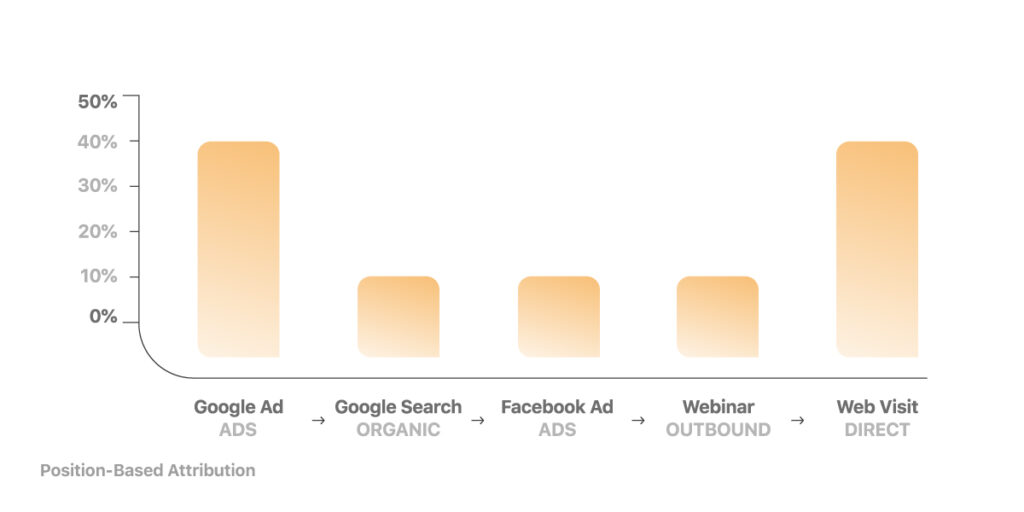
For example:
- A customer receives a Facebook ad for an office chair and visits the website to browse.
- A few days later the customer is served with a Google search ad while looking for office chairs, but doesn’t convert.
- The next day, the customer visits the website and makes a purchase after being retargeted with a Google display ad.
In this scenario the Facebook and Google display ad will each receive a balanced credit of 40%, while the Google display ad, which was the middle touchpoint, will receive 20%.
4. Linear Attribution
This multi-touch model takes into consideration the full conversion path and evenly credits every touchpoint a customer interacts with. Oftentimes linear attribution models are used more for illustration as opposed to truly measuring multi-touch performance. This model is beneficial for marketers that want to understand the value of touchpoints that introduce customers to their business, build consideration and produce conversions. Overall, if the goal is to understand a marketing strategy holistically, this model can be used accordingly.
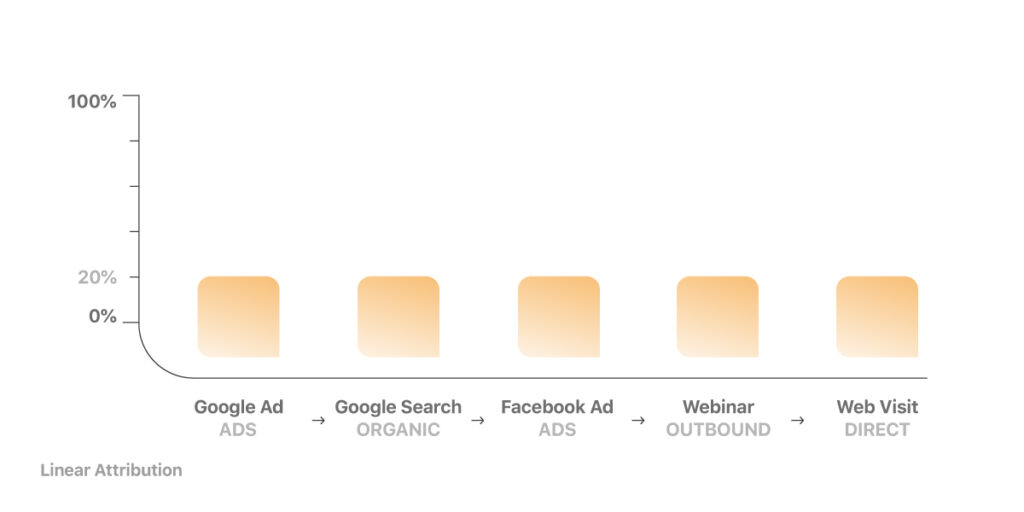
For example:
- A customer discovers a business’ sweatshirt from viewing a Snapchat ad and decides to visit its website.
- The next day the prospect is retargeted with a Facebook ad and visits the business’ website, but still doesn’t make a purchase.
- A few days later the prospect finally makes a purchase after clicking through a Pinterest ad from the business.
Using a linear attribution model, each of the three touchpoints will be credited with an even amount of attribution.
5. Time Decay Attribution
Similar to the linear attribution model, time-decay looks at the full conversion path. Credit is increasingly attributed in percentages to touchpoints as they get closer to the time of conversion. Initial touchpoints will garner less credit while the last interactions will collect the most.
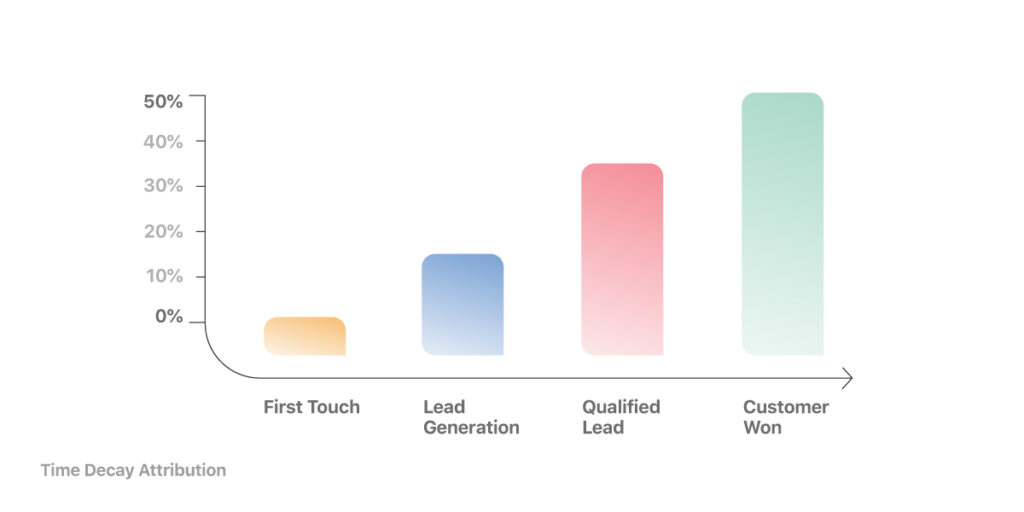
This model is beneficial to understanding the full customer journey and provides a realistic representation of how consumers build consideration through interacting with ads as they move closer to a conversion. In addition, time-decay attribution allows marketers to analyze which channels are main contributors to lower funnel in comparison to top funnel conversions.
For example:
- A customer is initially served a Facebook ad on their mobile phone for a t-shirt. They click through and browse the website.
- One day later the customer receives an email newsletter about the t-shirt.
- The customer then converts two days after clicking through a Google Search ad from the business while browsing for t-shirts.
The majority of the credit will be allocated to the Google search ad, while the email newsletter and Facebook ad will receive less credit respective of their touchpoint positions.
6. Data-Driven Model
Using platform-specific algorithms, data-driven modeling encompasses machine learning based on estimated incremental value. Credit is assigned to touchpoints that matter most with data-driven modeling and it’s oftentimes most accurate in comparison to other modeling types because of its specificity to a business. This attribution model typically requires a data scientist to analyze and interpret historical data to build and maintain. For smaller or newer businesses, this may be a more expensive option and using a standard attribution model is recommended.

Conclusion
With various different attribution models to select from, it’s difficult to choose one. However now equipped with an understanding of different models and how they credit conversion, the decision should become clearer. There simply isn’t a right or wrong answer, or a one glove fits all solution. The choice of which attribution model depends on a business’ end goal and marketing campaign.
For businesses that sell higher valued products, which require longer sales cycles, and more marketing channels, a multi-touch attribution model may be required. This will help marketers understand how a customer was introduced to the business, where they fell off, what made them revisit and ultimately why they converted.
Businesses that are trying to determine which channels provide them with new prospects and contribute to top funnel strategies may opt to utilize a first touch model. Alternatively, organizations that are trying to discover which channels are great at closing customers may lean towards a last touch model.
The best piece of advice we can offer is to select a model that provides your business with the information needed to maximize ROI, taking into consideration your touchpoints and sales cycle.
If you’re interested in taking your campaigns to the next level, let’s chat. We’re here to help!
The post How to Choose the Best Marketing Attribution Model appeared first on AdParlor.
Related Posts
Categories
- 60% of the time… (1)
- A/B Testing (2)
- Ad placements (3)
- adops (4)
- adops vs sales (5)
- AdParlor 101 (43)
- adx (1)
- algorithm (1)
- Analysis (9)
- Apple (1)
- Audience (1)
- Augmented Reality (1)
- authenticity (1)
- Automation (1)
- Back to School (1)
- best practices (2)
- brand voice (1)
- branding (1)
- Build a Blog Community (12)
- Case Study (3)
- celebrate women (1)
- certification (1)
- Collections (1)
- Community (1)
- Conference News (1)
- conferences (1)
- content (1)
- content curation (1)
- content marketing (1)
- contests (1)
- Conversion Lift Test (1)
- Conversion testing (1)
- cost control (2)
- Creative (6)
- crisis (1)
- Curation (1)
- Custom Audience Targeting (4)
- Digital Advertising (2)
- Digital Marketing (6)
- DPA (1)
- Dynamic Ad Creative (1)
- dynamic product ads (1)
- E-Commerce (1)
- eCommerce (2)
- Ecosystem (1)
- email marketing (3)
- employee advocacy program (1)
- employee advocates (1)
- engineers (1)
- event marketing (1)
- event marketing strategy (1)
- events (1)
- Experiments (21)
- F8 (2)
- Facebook (64)
- Facebook Ad Split Testing (1)
- facebook ads (18)
- Facebook Ads How To (1)
- Facebook Advertising (30)
- Facebook Audience Network (1)
- Facebook Creative Platform Partners (1)
- facebook marketing (1)
- Facebook Marketing Partners (2)
- Facebook Optimizations (1)
- Facebook Posts (1)
- facebook stories (1)
- Facebook Updates (2)
- Facebook Video Ads (1)
- Facebook Watch (1)
- fbf (11)
- first impression takeover (5)
- fito (5)
- Fluent (1)
- Get Started With Wix Blog (1)
- Google (9)
- Google Ad Products (5)
- Google Analytics (1)
- Guest Post (1)
- Guides (32)
- Halloween (1)
- holiday marketing (1)
- Holiday Season Advertising (7)
- Holiday Shopping Season (4)
- Holiday Video Ads (1)
- holidays (4)
- Hootsuite How-To (3)
- Hootsuite Life (1)
- how to (5)
- How to get Instagram followers (1)
- How to get more Instagram followers (1)
- i don't understand a single thing he is or has been saying (1)
- if you need any proof that we're all just making it up (2)
- Incrementality (1)
- influencer marketing (1)
- Infographic (1)
- Instagram (39)
- Instagram Ads (11)
- Instagram advertising (8)
- Instagram best practices (1)
- Instagram followers (1)
- Instagram Partner (1)
- Instagram Stories (2)
- Instagram tips (1)
- Instagram Video Ads (2)
- invite (1)
- Landing Page (1)
- link shorteners (1)
- LinkedIn (22)
- LinkedIn Ads (2)
- LinkedIn Advertising (2)
- LinkedIn Stats (1)
- LinkedIn Targeting (5)
- Linkedin Usage (1)
- List (1)
- listening (2)
- Lists (3)
- Livestreaming (1)
- look no further than the new yorker store (2)
- lunch (1)
- Mac (1)
- macOS (1)
- Marketing to Millennials (2)
- mental health (1)
- metaverse (1)
- Mobile App Marketing (3)
- Monetizing Pinterest (2)
- Monetizing Social Media (2)
- Monthly Updates (10)
- Mothers Day (1)
- movies for social media managers (1)
- new releases (11)
- News (72)
- News & Events (13)
- no one knows what they're doing (2)
- OnlineShopping (2)
- or ari paparo (1)
- owly shortener (1)
- Paid Media (2)
- People-Based Marketing (3)
- performance marketing (5)
- Pinterest (34)
- Pinterest Ads (11)
- Pinterest Advertising (8)
- Pinterest how to (1)
- Pinterest Tag helper (5)
- Pinterest Targeting (6)
- platform health (1)
- Platform Updates (8)
- Press Release (2)
- product catalog (1)
- Productivity (10)
- Programmatic (3)
- quick work (1)
- Reddit (3)
- Reporting (1)
- Resources (34)
- ROI (1)
- rules (1)
- Seamless shopping (1)
- share of voice (1)
- Shoppable ads (4)
- Skills (28)
- SMB (1)
- SnapChat (28)
- SnapChat Ads (8)
- SnapChat Advertising (5)
- Social (169)
- social ads (1)
- Social Advertising (14)
- social customer service (1)
- Social Fresh Tips (1)
- Social Media (5)
- social media automation (1)
- social media content calendar (1)
- social media for events (1)
- social media management (2)
- Social Media Marketing (49)
- social media monitoring (1)
- Social Media News (4)
- social media statistics (1)
- social media tracking in google analytics (1)
- social media tutorial (2)
- Social Toolkit Podcast (1)
- Social Video (5)
- stories (1)
- Strategy (603)
- terms (1)
- Testing (2)
- there are times ive found myself talking to ari and even though none of the words he is using are new to me (1)
- they've done studies (1)
- this is also true of anytime i have to talk to developers (1)
- tiktok (8)
- tools (1)
- Topics & Trends (3)
- Trend (12)
- Twitter (15)
- Twitter Ads (5)
- Twitter Advertising (4)
- Uncategorised (9)
- Uncategorized (13)
- url shortener (1)
- url shorteners (1)
- vendor (2)
- video (10)
- Video Ads (7)
- Video Advertising (8)
- virtual conference (1)
- we're all just throwing mountains of shit at the wall and hoping the parts that stick don't smell too bad (2)
- web3 (1)
- where you can buy a baby onesie of a dog asking god for his testicles on it (2)
- yes i understand VAST and VPAID (1)
- yes that's the extent of the things i understand (1)
- YouTube (13)
- YouTube Ads (4)
- YouTube Advertising (9)
- YouTube Video Advertising (5)
